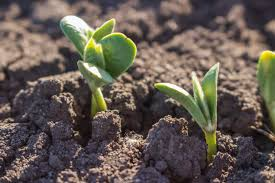I have said that starters may be the next edge to growing high-yield soybeans after adopting early planting. Most starter trials show little yield response, but those trials were conducted with soybeans planted in May and often after May 10 or 15. Today soybeans are being planted 20 to 30 days earlier and the results may prove to be different.
A question recently came in from a grower in Tazewell County on using starter fertilizer on soybeans and expressing some concern on seed safety. While he had record yields around 80 bu/A, he feels he can do better and is missing something in his program. The grower asked, “Some of the literature I am reading seems to point toward phosphorus (P) more than potash (K) for beans. I am thinking about applying some fertilizer for beans this spring, do you think it would be better broadcast dry? Or should I put on liquid with the planter? I have liquid equipment on the planter and currently apply nitrogen on both sides of the row behind the press wheels for corn. Please share your thoughts.”
in Tazewell County on using starter fertilizer on soybeans and expressing some concern on seed safety. While he had record yields around 80 bu/A, he feels he can do better and is missing something in his program. The grower asked, “Some of the literature I am reading seems to point toward phosphorus (P) more than potash (K) for beans. I am thinking about applying some fertilizer for beans this spring, do you think it would be better broadcast dry? Or should I put on liquid with the planter? I have liquid equipment on the planter and currently apply nitrogen on both sides of the row behind the press wheels for corn. Please share your thoughts.”
Well, every agronomist has advice to offer and I am no different. My response is based on my experience and knowledge gained over a couple decades. However, another agronomist with a different history and philosophy might have a different response.
If you have heard Fred Below’s The Six Secrets of Soybean Success, he says to fertilize beans and corn independently and most agronomists follow that today. The truth is that the P and K you apply before a corn crop will either be used up by the corn or tied up in the soil and not very available, leaving soybeans to scavenge from anything left in the water-based pool. Fertilize both crops independently.
Below’s Six Secrets also show that there is a greater response to P than K. We have always believed that soybeans need more K because their requirement is greater, so more emphasis was placed on K than P. But we also know the soil test levels for P have been dropping in Illinois due to harvesting much greater yields than we are fertilizing for. So Fred’s advice is to pay more attention to P but don’t totally forget K.
As an agronomist I believe that the closer you apply P and K to crop uptake the more will be available. Over time, soil chemistry and mineralogy will take phosphate and potash molecules and tuck them away so they are no longer immediately available. I am of the opinion that spring applications of dry are the most efficacious. Of course, most want to apply it in the fall because it can be done more easily. Regarding P, there are some products like Avail® on the market that keep it from ‘fixing’ in the soil.
And as with any fertilizer, the closer you band it to the rooting zone the more able the plant is to get it. The higher the concentration of nutrients placed in a band the less that will temporarily be tied up and the greater the in-season availability. Below puts down his P and K and some micros in a strip below the V trench. However, most farmers don’t strip till and must rely on broadcast applications.
With growers now planting soybeans at the same time as corn or starting before corn, applying starter fertilizer is even more important. I truly think this will be the next edge to high-yield soybeans. I know growers are sometimes scared of starter in furrow, but if you limit yourself to 2 to 2.5 g/A you will be okay, regardless whether it is a salt or no-salt starter. You can also put space between the seed and starter by putting it down in a 2 x 2 band and applying 5 or 10 gallons. Don’t dribble it over the top of the furrow the way you would do with N because P and K are considered immobile and wouldn’t move into the root zone.
At the end of the day what are the economics of broadcasting this spring vs. applying all with a starter? It will cost most to go all liquid. I believe there is a compromise—broadcast a dry and supplement with a band at planting to get the crop off to a good start. You will probably get your most economic response with a combination approach.
Several past articles on applying starter fertilizers on soybeans are available on the ILSoyAdvisor at:
2015 https://www.ilsoyadvisor.com/on-farm/ilsoyadvisor/agronomy-applying-starters-soybeans
2015 https://www.ilsoyadvisor.com/on-farm/ilsoyadvisor/plant-soil-health-starter-fertilizer-soybeans
2016 https://www.ilsoyadvisor.com/on-farm/ilsoyadvisor/agronomy-are-starters-value
2016 https://www.ilsoyadvisor.com/on-farm/ilsoyadvisor/agronomy-applying-starter-doable




 and then
and then